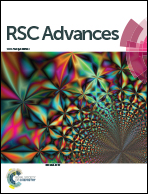Oil removal from water–oil emulsions using magnetic nanocomposite fibrous mats†
Abstract
Herein we present the fabrication of hydrophobic and oleophilic poly(methyl methacrylate)-based nanocomposite fibrous mats with magnetic properties, and their utilization for oil removal from stable water–oil emulsions. The incorporation of ferromagnetic iron nanoparticles into the polymeric fibers increases the selectivity and oil removal performance of the fibers, as well as introduces magnetic actuation properties to the material. In all the water–oil emulsions used in this work ranging from 5 to 30 v%, the functional mats can obtain oil absorption efficiencies up to 90%. The oil removal efficiency can reach nearly 100% with just two successive absorption cycles. The high performance achieved makes the presented material a promising candidate for efficient water–oil emulsions separation.



 Please wait while we load your content...
Please wait while we load your content...